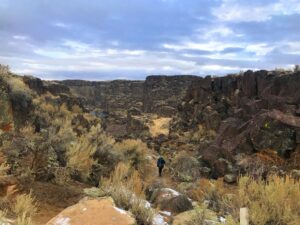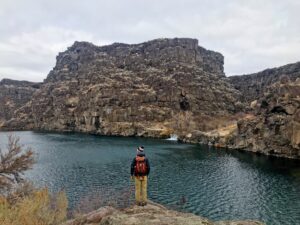ICL staff adventured to one of the Magic Valley’s wildest canyons
The Snake River is the lifeblood of southern Idaho and a mighty force. Across millennia, its waters have carved deep canyons in the desert basalt, plunging over waterfalls of staggering heights, irrigating the agricultural heartland of the state, and providing drinking water for over 300,000 Idahoans that derives from the vast Eastern Snake Plain Aquifer. It also creates some of the most surprising and wild geologic features found anywhere in the state.
Exploring the natural landscape of the Snake River canyon ignites one’s sense of wonder and shows how truly precious the river and its water are. Blue Heart Springs, Box Canyon, Malad Gorge, and Thousand Springs are just some of the destinations in the area to explore. On an outing to another of the Magic Valley’s wilder places, we experienced this wonder for ourselves. We haven’t named this place as we thought it might be fun for you to discover it for yourselves.
Exploring a Geologic Marvel
Home to deep pools of clear, cool water fed by natural springs that pour out of basalt columns, the landscape of the Snake River canyon is full of unexpected and unique geologic features. Though many of these would make perfect swimming holes for hot summer afternoons, Josh, Jonathan and I ventured to one of these incredible spots on a gray December day with flurries of snow starting to fall and not a soul around.
Bundled against the cold and masked due to COVID-19 precautions, the three of us hiked down into this side canyon, soon catching a glimpse of a natural lake. Snowfall from weeks before remained on the shady canyon trail and trekking poles provided much needed balance on the way down to the waters. Traction devices like Yaktrax may be necessary if there’s snow/ice. All around us towered basalt cliffs. Winter birds soared across the sky. On the other side of the lake, a waterfall poured in from a side canyon. Adventure beckoned from every direction, each scramble promising a different view of the lake and a new perspective on the twisting canyon.
 The geologic setting of the lake is spectacular. The lake is cradled within the blocky walls of 2 million-year-old basalt rock carved out by the great Bonneville Flood about 14,500 years ago. At that time, a massive Ice Age lake in the vicinity of the present-day Great Salt Lake discharged an enormous rush of water north into the Snake River watershed, with the flood following the present course of the Snake River. East of Twin Falls, the flood waters diverted north of the Snake River canyon and scoured a long stretch of basalt, forming Vineyard Lake, Devils Corral, Shoshone Falls and Twin Falls waterfall.
The geologic setting of the lake is spectacular. The lake is cradled within the blocky walls of 2 million-year-old basalt rock carved out by the great Bonneville Flood about 14,500 years ago. At that time, a massive Ice Age lake in the vicinity of the present-day Great Salt Lake discharged an enormous rush of water north into the Snake River watershed, with the flood following the present course of the Snake River. East of Twin Falls, the flood waters diverted north of the Snake River canyon and scoured a long stretch of basalt, forming Vineyard Lake, Devils Corral, Shoshone Falls and Twin Falls waterfall.
The area that we visited was designated an Area of Critical Environmental Concern (ACEC) in the 1980s by the Bureau of Land Management (BLM) because of its geology, scenic values and rare species. The creek at the outlet of the lake is the only local spawning habitat of the redband trout, a unique subspecies of rainbow trout. While recreation is allowed at the lake, the BLM doesn’t maintain recreation infrastructure or trails to the spot, resulting in a wilder experience for visitors (sadly marred by the sheer volume of garbage we found throughout the area).
 We spent the afternoon scrambling around the lake and the springs. Getting to the lake’s source, a peaceful and lush spring that flows directly out of the canyon walls, required creative maneuvering through tall grasses and vegetation armed with opportunistic burrs that seized the chance to hitch a ride on my socks, shoe laces and fleece gloves. Though the scenery provided a sense of solitude, the echoing sounds of trucks zipping down I-84 reminded us of the modern world all around us.
We spent the afternoon scrambling around the lake and the springs. Getting to the lake’s source, a peaceful and lush spring that flows directly out of the canyon walls, required creative maneuvering through tall grasses and vegetation armed with opportunistic burrs that seized the chance to hitch a ride on my socks, shoe laces and fleece gloves. Though the scenery provided a sense of solitude, the echoing sounds of trucks zipping down I-84 reminded us of the modern world all around us.
Though we attempted to circumnavigate the lake, we were thwarted by many hazards, including cliffs and a sketchy plank bridge that we weren’t inclined to walk. If you are considering visiting the Snake River canyon, use common sense and be cautious of the many hazards found in the area. Slick scrambles, tall cliffs, thick vegetation and open water all pose significant risks to recreators. Remember that in certain places rescuers will have a hard time reaching you if you need help. Treat your adventures in southern Idaho’s basalt canyons like a walk in the wilderness — be prepared to self-rescue, pack out all your trash, and respect the landscape and its wildlife.
On the way back, we took a detour to the canyon rim. As always, the views of the Snake River from the canyon’s edge were extraordinary, with a stunning look at the horizon line of Twin Falls (the falls, not the city) down below. We ended our adventure here above the canyon, reflecting on the sheer beauty of the Snake River landscape and feeling inspired to continue the work of ensuring the Snake River is a healthy, clean and safe waterway for all to use and enjoy.
Restoring the Snake River
The Snake River and its aquifer are fundamental not just to Idaho’s agriculture and aquaculture industries, but to the health, well-being, and quality of life of all who depend on its waters. Unfortunately, the river and aquifer are polluted by agricultural runoff, dairy waste, and discharge from fish farms. These pollutants, primarily phosphorus and nitrate, threaten water quality across Southern Idaho, creating problems for the river’s ecosystem and endangering the health of those who rely on the aquifer for drinking water. The source of the Snake River’s contamination is tied to the Magic Valley’s agricultural landscape where aerial photos show a sprawling patchwork of massive industrial dairies and farm fields. While the Magic Valley’s environment is heavily shaped by agricultural use, it is also a region full of hidden gems revealing the geologic power and beauty of the Snake River.
A clean and safe Snake River is vital to a healthy and prosperous future for southern Idaho. Declining water quality affects everyone who relies on the Snake River. ICL is working on a campaign to clean up the Snake River across southern Idaho and restore water quality to safe and healthy levels. But to ensure that the Snake River is a safe place to swim, fish and recreate, the river requires a bold effort to address the worsening problems from agricultural pollution. Our vision for Idaho’s Snake River celebrates the importance of the river and its water for agriculture, drinking water and world-class outdoor adventures.
Take Action! Use your voice to let Idaho’s policymakers know that you want to see the Snake River restored.

